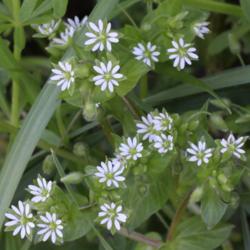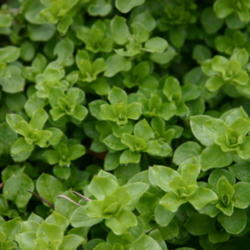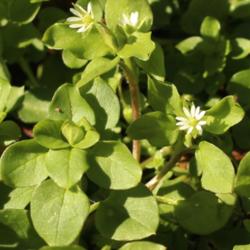Whenever I give a talk to a garden club or group of master gardeners, I always make sure to spend a few minutes talking about one of my favorite plants, chickweed. Every person needs to know about this useful (and deliciously edible) plant.
If you are very lucky, starting in January and continuing well into spring you'll start seeing mats of
chickweed grow. They'll come up in your lawn, landscaping, orchard, wood edge, and anywhere else. The leaves are small, oppositely arranged on a lightly pubescent stem, about 1/4" long. Their flower buds are distinct and positioned at the end of a very long pedicel (the stem). The diminutive blooms have five sets of double petals, giving the appearance of ten petals. The main stems are quite fibrous, and if you pull off the outside layer, you'll find an unusual elastic interior that can stretch when pulled!
These are winter-growing annuals and are hardy in temperatures well into the teens. They prefer shady conditions, with mesic to wet conditions, and fertile soil. If your soil is high in nitrogen, you'll find chickweed produces truly prodigious growth. They seem to be edge lovers, growing up against the house or at the edge of a garden. If you have a wooded area you'll often find it growing along the edge.
So what's so great about chickweed? Well, primarily, it's edible, and by edible I don't mean it won't kill you to eat it. I mean it's an incredibly tasty green vegetable that is loaded with good vitamins and grows naturally, so you don't even have to work to plant it. Forget spinach and lettuce. When chickweed is out, that's the treat you want. Go out to the garden and pick as many handfuls of the stuff as you can carry. Bring it in and begin the admittedly tedious process of picking off all the leaves into a bowl. From there you can eat them raw, toss them in a salad, cook them in numerous ways, add them to soups, etc. Around our farm, most of our chickweed diet is consumed outdoors while standing in the garden. Just reach down, pick a bunch, and start eating.
While every part is edible, the fibrous stems aren't that great and you have to chew forever and you seem to never get anywhere with it, and this is why it's recommended to just eat the leaves, buds, and flowers.
If you've read my previous articles, you know that I'm a big fan of dynamic nutrient accumulators, which are plants that "mine" nutrients from the soil and make them available in their above-ground parts. Chickweed is one such plant, accumulating phosphorus, potassium, and manganese. When you eat these leaves you are taking in these valuable nutrients. It is also a good source of vitamin C, beta-carotene, calcium, niacin, riboflavin, zinc, copper, and Gamma-linolenic-acid (a form of omega-6 fatty acid).
When the weed is allowed to grow in the garden or orchard, those nutrients are brought closer to the surface for the benefit of the companion plantings. As an added bonus, it's a valuable source of nourishment to honeybees early in the spring.
It is a weed, true, and will grow in some places you may not want it. The seed pods each throw hundreds of seeds and that means you can end up with a carpet of the stuff each winter. Don't worry, though, as it's such an easy plant to deal with. By the time April comes along, the chickweed will completely die away and by May it's a distant memory, even if its benefits are continuing to be felt. During springtime the less desirable weeds start germinating, and a carpet of chickweed makes an excellent living mulch to protect your soils.
As its name suggests, chickweed is also excellent for feeding to poultry. Historically, people have hatched chicks in the early spring, and raised those chicks on a primary diet of chickweed. We encourage its growth in our orchards and around our chicken pens.
Seems like that should be enough, right? No! It also has a long history of medicinal uses, especially in the treatment of skin disorders like eczema. The leaves placed in a muslin bag and boiled for a couple minutes, then applied to a skin rash or abscess, will reportedly provide quick healing or relief. Tea made from chickweed is used as a tonic to treat constipation. Due to its high levels of vitamin C, it has been used in the past to ward off scurvy in the winter. Do some googling on the medicinal values of chickweed and you'll find more than you ever want to know, and see words like post-partum depurative, emmenagogue, galactogogue, and circulatory tonic, and you'll realize that there's more to this plant than you can ever learn.
So go outside today, locate a patch of chickweed, and give it a taste. You'll instantly be hooked, and you'll be grateful that you were introduced to this prince of weeds.


